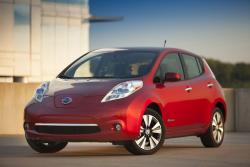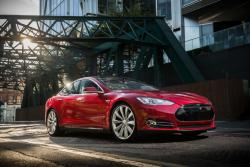Ford Focus EV. Click image to enlarge |
Article by Steven Bochenek
Green cars? Really? First of all, you could argue for hours on what constitutes greenness. So the Green Car Awards made some decisions. The bigger issue is one of relevance. That is, if you really want to make an environmental difference, why not just get a bamboo bike, put a battery on it that you could power for each evening’s light, then feed the bike to some pandas when it falls apart?
Because for most of us, it’s not realistic – yet that doesn’t mean we don’t care and can’t contribute in our way.
John Lennon expressed it well in ‘Revolution’ (can you believe that song was a B-side?) when asked “for a contribution… We’re all doing what we can.” In other words, you can make small healthier choices for yourself and the environment. It’s about nuance and degrees. Consider Lennon’s erstwhile partner, McCartney. He knows a steak-loving man’s man like many of our readers would never become vegan, but maybe he’d consider a Meatless Monday a day off for an overtaxed colon.
For those in the market for a new car, doing what we can means investigating what renders the best mileage and who’s leaving the biggest footprint. For the wealthier ones, it could mean buying a few of the sexier beasts shown off in this year’s list of entrants, below. For the rest of us, it means driving more consciously with a lighter foot and making a paid-for vehicle last longer before making it landfill.
The Green Car Awards exist to feature innovative technologies that milk the energy required to power them exceptionally well. Plus it offers the manufacturers a chance to explain how greenly the car was made. So the show is for all of us in the doing-what-we-can camp.
How it works.
There are five categories in this second year’s annual offerings, each containing either three or four entrants: 1) Battery Electric 2) Plug-in Hybrid 3) good ol’ Hybrid 4) Efficient Gasoline or Diesel Internal Combustion and 5) the catchily named Efficient Three-Row Vehicle.
There are seven ways to earn points, each of which falls within one of two larger judging sections:
 Nissan LEAF SV. Click image to enlarge |
• Section One, Environmental Attributes, contains three categories:
1) Overall green appeal
2) Green features outside of the drive train
3) Corporate environmental sensitivity.
• Section Two, Mass-Market Appeal, contains the remaining four:
4) Driving experience
5) Perceived quality
6) Overall features for this price and
7) Comfort.
Judges rated each category out of 10. However, that doesn’t mean each category factors equally into the final score. (After all, when you’re saving the world comfort shouldn’t trump green features.)
Overall Greenness, Driving Experience and Green Features are worth 10% of the final mark, each, while Comfort, Overall features, Perceived quality and Corporate Sensitivity each get 5%. Which totals 50%.
And the other 50%? According to Lead Judge, Eric Novak, it was rated and weighted by objective facts like “fuel economy, range, emissions and price.” (Confused? That’s OK. At the risk of sounding obvious, you’ll agree that green isn’t black and white.)
Now, these are the entrants and two of their greener features or innovations.
 Tesla Model S. Click image to enlarge |
Category 1: Battery Electric
Ford Focus EV
It fully recharges in four hours with the available wall-mounted 240V charge station. Its SmartGauge and Ecoguide provide instant feedback on your driving with simple graphics, so you can wring the greatest efficiency from each venture onto the roads.
Kia Soul EV
It’s so new, Kia only had one in the country on the day before judging was finished. The regenerative braking, however, is third generation and captures up to 12 percent of its otherwise wasted kinetic energy. Many of its plastics throughout the cabin are bio-based, made from cellulose and sugar cane. (If it runs out of juice in the wilderness, maybe you – or the pandas – could eat it.)
Nissan Leaf SV
This car was the first to the party. It’s been about innovating its own technologies since. 20 percent of the Leaf is made from recycled materials. Its 6.6kW onboard charger reduces 220V charging by almost half to around four hours from void to full charge.
Tesla Model S
Its EPA-certified range is 425 km. Of course, you need to drive very carefully to attain that, but it’s excellent. Tesla’s Supercharger can recharge half the battery in half an hour, making electric a more realistic option for travel beyond a city commute. (It also has Wi-Fi, making it a rolling office or playground.)










